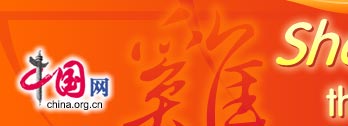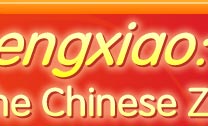| In the Chinese zodiac, twelve
animals are used to denote the year of a person's birth: rat,
ox, tiger, rabbit, dragon, snake, horse, sheep, monkey, rooster,
dog and pig. This is called a person's shengxiao (sheng
means the year of birth, xiao means resemblance) or
shuxiang.
Since ancient times, Chinese have denominated years using
combinations of 10 Heavenly Stems and 12 Earthly Branches
to form sixty-year cycles. The 10 Heavenly Stems are: Jia,
Yi, Bing, Ding, Wu, Ji,
Geng, Xin, Ren and Gui.
The 12 Earthly Branches are: Zi, Chou, Yin,
Mao, Chen, Si, Wu, Wei,
Shen, You, Xu and Hai.
This year, February 9 is the first day of Yiyou,
which is the twenty-second year of the sixty-year cycle.
As well as being associated with each year, the same twelve
animals and Earthly Branches are assigned to each month and
to a two-hour period of the day. Their origin is variously
explained by a number of stories and theories.
One legend is that the order of animals is the result of
squabbles that followed Emperor Xuanyuan's summoning them
to be his imperial bodyguards. The rat tricked the cat out
of going, and ever since they have been enemies. The rat also
managed to drive the elephant away by climbing into his trunk.
Of the other animals, the ox took the lead, but the rat jumped
onto its back, hitching a ride into first place. The pig,
busy complaining about this, came last. Since the tiger and
dragon refused to accept the result, the Emperor compensated
them with the titles "King of the Mountain" and
"King of the Ocean," and placed them immediately
after the rat and ox. But the rabbit would not accept this
either, so raced and won against the dragon for fourth place.
The dissatisfied dog bit the rabbit, and was punished with penultimate
place. The other animals filled the other positions in the
order in which they arrived.
The use of 12 animal symbols is not unique to the Hans in
China. Many minority ethnic groups have their own series with
minor differences. For example, Mongolians use tiger, rabbit,
dragon, snake, horse, sheep, monkey, rooster, dog, pig, rat
and ox; the Dai people use rat, ox, tiger, rabbit, dragon, snake,
horse, sheep, monkey, rooster, dog and elephant; and the Li
people use rooster, dog, pig, rat, ox, tiger, rabbit, dragon,
snake, horse, sheep and monkey. Some believe that the Han inherited
their twelve from northern tribes in ancient times. Another
possibility is that exchange between different cultures cultivated
the various sequences of twelve.
Shengxiao are held to be of great significance by
many Chinese, and people tell numerous stories and follow
rich and colorful customs associated with the Earthly Branches:
 |
|
Rat
(1924 – 1936 – 1948 – 1960 – 1972 – 1984 – 1996 – 2008
– 2020 – 2032)
Zi means seed, fruit, root
and inheritance. It represents due north, the eleventh
Chinese lunar month, when many animals begin to hibernate,
and 11 PM to 1 AM, when the rat is most active.
|
 |
|
Ox
(1925 – 1937 – 1949 – 1961 – 1973 – 1985 – 1997 – 2009
– 2021 – 2033)
Chou corresponds to the ox. The shape of its
Chinese character is like threads coming together to
form a strong rope, so represents things being connected.
It denotes the twelfth lunar month, known in some places
as Muyue or "month of harmony." In northern
China, it is freezing winter, when people gather round
the fire and wait for spring. It also stands for 1 PM
to 3 PM, when the ox is chewing the cud, and even the
grass and trees are thought to be asleep.
|
 |
|
Tiger
(1926 – 1938 – 1950 – 1962 – 1974 – 1986 – 1998 – 2010
– 2022 – 2034)
Yin is associated with northeast by east and
3 AM to 5 AM, when the tiger is most ferocious. In the
Chinese lunar calendar it represents month one, the
time trees begin to sprout.
|
 |
|
Rabbit
(1927 – 1939 – 1951 – 1963 – 1975 – 1987 – 1999 – 2011
– 2023 – 2035)
Mao represents due east and 5 AM to 7 AM,
when the moon, the home of the legendary jade rabbit,
still hangs in the sky. It also denotes the second lunar
month, a time of reawakening and new life. The rabbit's
relatively meek temperament makes it an appropriate
symbol for the sun just coming up over the horizon.
|
 |
|
Dragon
(1928 – 1940 – 1952 – 1964 – 1976 – 1988 – 2000 – 2012
– 2024 – 2036)
Chen symbolizes southeast by south and 7 AM
to 9 AM, believed to be the best time for the magic
dragon to generate rain and when the sun strengthens
and everything is about to wake up. The dragon is the
only mythological animal in the system, and was considered
one of the "four sacred animals" along with
the phoenix, kylin and tortoise. It was imagined to
have a horse's head, snake's body and chicken's claws,
with 81 scales on its back. It could fly and swim, and
appear and disappear mysteriously. In the Chinese lunar
calendar, it represents month three.
|
 |
|
Snake
(1929 – 1941 – 1953 – 1965 – 1977 – 1989 – 2001 – 2013
– 2025 – 2037)
Si represents south by east and 9 AM to 11
AM, when the snake is most lively. It is associated
with the fourth lunar month, when green abounds and
seedlings begin to grow.
|
 |
|
Horse
(1930 – 1942 – 1954 – 1966 – 1978 – 1990 – 2002 – 2014
– 2026 – 2038)
Wu stands for due south and the time around
noon, when the sun is most severe. It is believed that
11 AM to 1 PM is when horses travel best. It also signifies
the fifth lunar month, when farmers till the land and
everything is full of vigor.
|
 |
|
Sheep
(1931 – 1943 – 1955 – 1967 – 1979 – 1991 – 2003 – 2015
– 2027 – 2039)
Wei represents the sixth lunar month and the
height of summer. It also stands for 1 PM to 3 PM, when
it is said that if a sheep eats a patch of grass it will
grow more luxuriously, and for the direction of southwest
by south. The sheep represents love, happiness and perseverance
of spirit.
|
 |
|
Monkey
(1932 – 1944 – 1956 – 1968 – 1980 – 1992 – 2004 – 2016
– 2028 – 2040)
Shen's character in Chinese looks like two
hands grasping a stick and, with one addition, becomes
another shen meaning to stretch, with the implication
of using one's mind to the full and with flexibility.
3 PM to 5 PM is believed to be when monkeys play.
|
 |
|
Rooster
(1933 – 1945 – 1957 – 1969 – 1981 – 1993 – 2005 – 2017
– 2029 – 2041)
You represents the eighth lunar month in early
autumn and 5 PM to 7 PM, when the sun sets and the rooster
returns home - an animal considered by many to be associated
with prophecy. You also symbolizes due west.
|
 |
|
Dog
(1934 – 1946 – 1958– 1970 – 1982 – 1994 – 2006 – 2018
– 2030 – 2042)
Xu, associated with the dog, represents northwest
by west, 7 PM to 9 PM, when the dog is said to watch
the night, and the ninth lunar month, when grass and
trees start to wither but the weather is pleasant.
|
 |
|
Pig
(1935 – 1947 – 1959 – 1971 – 1983 – 1995 – 2007 – 2019
– 2031 – 2043)
Hai represents month ten in the Chinese lunar
calendar, when everything begins to stagnate. It also
represents 9 PM to 11 PM, when all is silent apart from
the pig's snores.
|
|


